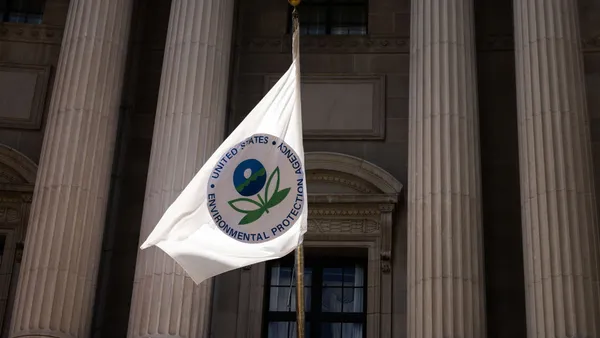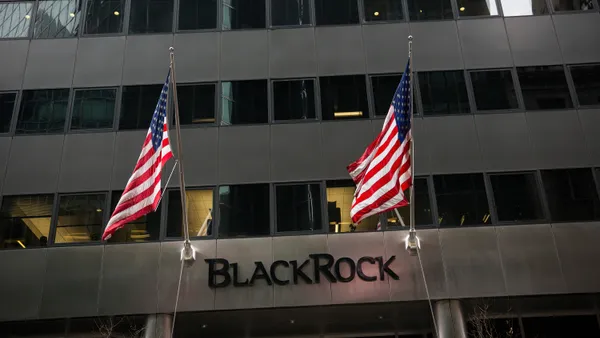Dive Brief:
- Netherlands-based multinational bank ING Group announced Wednesday that its net-zero targets have been validated by the Science Based Targets initiative, becoming the first global bank to have such a verification.
- ING’s freshly validated 2030 targets, also published Wednesday, include a commitment to reduce its absolute scope 1 and scope 2 emissions by 44%, compared to a 2023 baseline, and scope 3 portfolio targets that cover at least 67% of the bank’s portfolio. The sector targets also include goals related to the bank’s fossil fuel financing.
- ING said its targets were set using the organization’s near-term criteria for financial institutions, a framework that was updated last year with additional guidelines from SBTi. The global organization validates that organizations' climate goals align with climate science.
Dive Insight:
ING’s emissions scope 3 portfolio emissions reductions targets also include sector targets for the fossil fuel, power generation, cement, steel, automotive, aviation and commercial real estate industries. The global bank also committed to increasing its annual renewable energy sourcing from 98.3% of its electricity consumption to 100% by the end of the decade as part of its scope 1 and scope 2 emissions reduction efforts, according to the published targets.
The Dutch bank’s sustainability focus includes facilitating and financing “society’s shift to a low-carbon future and pioneer[ing] innovative forms of finance to support a better world,” according to its website. ING also said sustainability makes up an “integral part” of its strategy.
ING’s portfolio targets cover 63% of the bank’s total investment and lending based on financed emissions, and 5% of its total investment and lending as of 2021. ING Global Head of Sustainability Anne-Sophie Castelnau stated that having SBTi validate its targets “demonstrates that they are science-based and robust.”
“[ING] will continue to engage with clients and support them in driving down emissions, keep building up the financing of new technologies and sustainable systems of the future, and find ways to include everyone and enable them to play their part in the transition,” Castelnau said in the release.
The portfolio targets, set under SBTi’s second version of near-term target-setting standards for financial institutions, include a commitment by ING to annually publicly disclose “all of its financial activities by loan commitment and exposure as well as the GHG emissions attributed to its applicable loans, investments and assets under management” for projects from companies in the coal, oil and gas sectors separately.
The bank also committed to immediately end new financing for projects and companies looking to create new coal mines, extend or expand coal mines or “new unabated coal-fired power plants.” It also ended new financing financing “new long-lead time upstream oil and gas projects and midstream infrastructure dedicated to new long-lead time upstream oil and gas projects” and companies working on such oil and gas activities, according to the target document.
ING’s fossil fuel sector commitments include a goal to halve greenhouse gas emissions from upstream oil and gas sector companies in its corporate loan portfolio by 2030, compared to a 2019 baseline. The bank said it also committed to phasing out financing activities for “all non-decommissioning” coal companies and projects by 2025.
The fossil fuel disclosures were required as part of SBTi’s update to the financial industry framework, which also marked the first time that public banks and asset managers were looped into the standard. The updated criteria for fossil fuel finance targets included options for companies to disclose, halt, transition and phase out fossil fuel financing.
ING’s 2030 portfolio targets also include sector goals to reduce:
- “All in-use operational” greenhouse gas emissions from its commercial real estate loan portfolio 56.4% per square meter, from 2022;
- GHG emission from electricity generation sector companies within its corporate loan and project finance portfolios 78% per megawatt hour, from 2018;
- Carbon dioxide emissions from the cement sector 29% per ton of cement, from 2020;
- Carbon dioxide emissions in its corporate loan portfolio from the steel sector 28% per ton of steel, from 2021;
- Carbon dioxide emissions from the auto sector in its corporate loan portfolio 49% per vehicle kilometer, from 2020; and
- Carbon dioxide emissions from the aviation sector in its corporate loan portfolio 19% per revenue tonne kilometer, from 2023.
SBTi’s Head of Financial Standards Nate Aden said in the March 26 release that the validation “marks an exciting milestone in the SBTi’s mission to drive science-based climate action across the global economy.”
“As the first global systemically important bank with a validated science-based target, ING is showing how large financial institutions can support climate stabilisation in the real economy,” Aden said. “The combination of six sector targets with cross-portfolio fossil fuel targets sets a new precedent for climate leadership.”
Companies representing nearly 40% of the global market cap reported either having SBTi-validated targets or a commitment to do so, as of 2023. SBTi released a draft update to its Corporate Net-Zero Standard last week, which would change the scope of target-setting requirements for companies and introduce tailored requirements based on company size and geography.
SBTi is seeking input on that draft standard until June 1.












